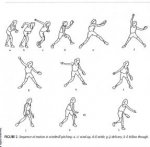I believe it's in one of the early posts in the I/R in the Classroom thread - there's a statement made (by BoardMember, IIRC) that the pronation/supination movement of the forearm is the fastest body movement.
I spent a good deal of time trying to verify that statement, learning about linear velocity, angular velocity, the actual speed of "a blink of the eye" (much slower than you'd think), but nothing confirming the above statement.
We have our first rec team practice for the Fall tonight (finally!), and was going to try and use the demonstration of showing the kids (and parents) how much faster they could "spin" their wrists and forearms (IR), compared to the speed of flexing your elbow and wrist when using HE mechanics.
Can anyone point me in the right direction? I really, really doubt anyone's going to ask me to cite a reference, but I also don't want to be dispelling one myth by creating another one.
Thanks for the help,
Gags
I spent a good deal of time trying to verify that statement, learning about linear velocity, angular velocity, the actual speed of "a blink of the eye" (much slower than you'd think), but nothing confirming the above statement.
We have our first rec team practice for the Fall tonight (finally!), and was going to try and use the demonstration of showing the kids (and parents) how much faster they could "spin" their wrists and forearms (IR), compared to the speed of flexing your elbow and wrist when using HE mechanics.
Can anyone point me in the right direction? I really, really doubt anyone's going to ask me to cite a reference, but I also don't want to be dispelling one myth by creating another one.
Thanks for the help,
Gags




